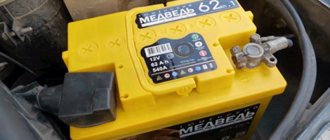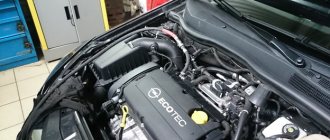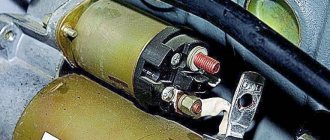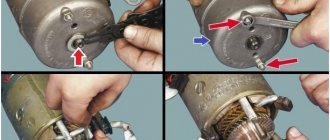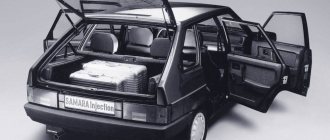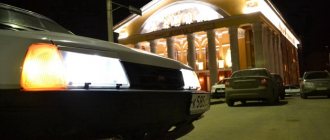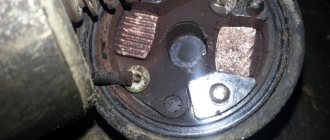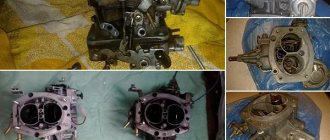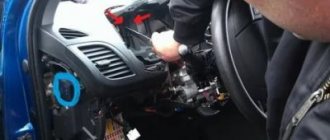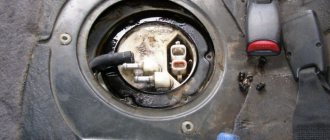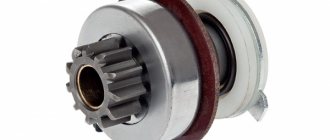The starter is one of the main links in the ignition system. The correct operation of this unit is responsible for starting the internal combustion engine. Reasons why the mechanism may fail: problems with the solenoid relay, discharged battery, opening of the ground contacts, ignition malfunction, violation of the integrity of the electrical wiring, etc. We will discuss the development mechanism, fault diagnosis and methods for eliminating them in more detail in the article.
Troubleshooting
You can often hear the phrase from car enthusiasts: “I get into the car, turn the key in the ignition, and nothing happens.” This occurs due to a breakdown of the starter unit or its electronics if:
- under the hood there are extraneous sounds (clicks, ringing, buzzing), but nothing happens;
- The engine will not start;
- The starter spins when starting, but the engine does not start;
- the crankshaft rotates slowly and the engine is silent;
- You can hear knocking noises under the hood, crackling gears and grinding noises.
A little theory: what is an electric starter
A car starter is a compact DC electric motor, a commutator type, on the shaft of which there is a gear that matches the profile of the teeth on the flywheel. A traction relay (solenoid) is screwed onto the body of this electric motor, the core of which, at the moment the key is turned, pushes the gear into engagement with the flywheel and at the same time - closes the contact plate - makes a “bridge” for powering the windings.
Starter device
The rotor just has to apply force, turn the flywheel and start the engine. The force is usually applied through a reduction gearbox, since the standard rotation speed of the motor is high. While the trigger mechanism is spinning, the Bendix gear will be pressed against the flywheel. To prevent the engine from starting to rotate the starter itself after starting, this gear was placed on an overrunning clutch, which opens the engagement when the speed of the flywheel becomes greater than the speed of the gear. The Bendix is engaged by a “fork-lever”, which is pumped by the “traction” core. As soon as the internal combustion engine starts and the key returns to its previous position - the current in the relay winding disappears, the gear returns under the housing, remaining fixed there.
The most common causes of breakdowns
These are faults in the electrical circuit. These include:
- battery charge less than 12 V;
- oxidation of contacts;
- lack of current on the solenoid relay;
- breakage of the solenoid relay;
- wear of the brush assembly;
- armature commutator wear.
In the case when the retractor does not work and the starter is silent when the key is turned, the breakdown may be the result of a short circuit or open circuit to ground of the traction relay, or short circuit of the turn.
The culprit is electronics even if, when the ignition is activated and the engine starts, the flywheel disk rotates too slowly.
The mechanical causes of malfunctions can be judged by the lack of rotation of the crankshaft when the starter is working. When turning the key, the engine may not operate in the following cases:
- the slip clutch is broken;
- the release lever is faulty or disconnected from the axle;
- the buffer spring is worn out;
- Drive ring is broken or worn.
How to start a car - the starter does not turn
If the starter is faulty due to the solenoid relay, then the car engine can be started if the contacts are closed forcibly. This is an emergency measure, but it is sometimes used when there is an emergency.
Let's look at an example of how to start the engine of a VAZ-2110 car.
- Place the gearshift lever in neutral position.
- Pull out the handbrake handle.
- Turn the ignition key and open the hood.
- Remove the air cleaner from its seat and move it to the side to provide access to the starter.
- Disconnect the plug from the contacts.
- Connect the two contacts of the pull-in relay together with a metal object or thick wire.
- If the other components are working properly, the engine should start.
Install the air filter and connect the wires. In many cases, the engine then starts without problems using the ignition key. But the problem has not disappeared, so you need to contact a workshop soon.
There is another method that is suitable for an urgent emergency start. It can only be used for cars with front-wheel drive and manual transmission.
Procedure:
- Raise the car with a jack so that one of the front wheels is suspended.
- Turn the raised wheel all the way.
- Wrap a rope or cable around the tire 3 turns, leaving an end 2 meters long.
- Turn on third speed.
- Turn on the ignition by turning the key.
- Pull the cable sharply, spinning the wheel and running away.
- After starting the engine, place the gearbox lever in the neutral position. You don't have to press the clutch pedal to do this. Wait for the wheel to stop.
- Use a jack to lower the car to the ground.
Attention!
The described method requires caution and safety measures. Otherwise, you may damage the vehicle and injure yourself.
This method is similar to starting with a handle on old cars, for example, Moskvich-412, or VAZ-2101. The raised wheel powers the gearbox and then the engine.
Lack of contact in the starter circuit
Occurs as a result of metal corrosion or loosening of bolted wires. In addition, you need to check the grounding of the retractor and main relay of the starter assembly. You can check your car's electronics using a multimeter. Before doing this, inspect the wiring, tighten the bolts and check the terminals. If there is contact loss, restore their integrity.
Why does the engine rotate inefficiently?
There are times when the starter works, but does not turn the engine with the required force. Let's list the situations when this happens:
- When using oil that does not correspond to the temperature conditions. The lubricant thickens and prevents the crankshaft from rotating. It is necessary to replace the lubricant with one regulated for the given weather conditions.
- Low battery charge. Does not provide energy for effective rotation. The battery needs to be recharged or replaced.
- In case of a malfunction of the brush assembly. It is necessary to check the contacts of the brushes and the tightening force of the tips going to the part.
The reasons that the starter does not turn may be a malfunction of the retractor relay, a weak battery charge, bad electrical contacts in the circuit, mechanical failure of the starter, and so on. It will be useful for every car owner to know what to do if the starter does not turn the engine. Indeed, in most cases, repairs can be done yourself. Moreover, a breakdown usually occurs at the most unforeseen moment, when it is not possible to use the help of a car repairman. Next, we will consider in detail the causes of the malfunction and methods for eliminating them.
Signs of a faulty starter
There are actually many reasons why a car won't start. However, a starter malfunction can be determined by the appearance of one or more of the following symptoms: - the starter does not turn on; — the starter clicks, but does not turn the engine crankshaft; — when the starter is turned on, the crankshaft rotates very slowly, which is why the engine does not start; - you can hear the metallic grinding of the Bendix gear, which does not engage with the crankshaft. Next, let's move on to discussing the possible causes of a possible breakdown. In particular, we will analyze situations when the starter either does not rotate at all or does not rotate the engine crankshaft.
Reasons why the starter does not turn
Often the reason that the car does not start and the starter does not turn the flywheel is a discharged battery. This reason is not directly related to the breakdown of the starter, however, before diagnosing this unit, it is necessary to check the charge of the battery and, if necessary, recharge it. Most modern car alarms block the starter circuit if the voltage level from the battery is 10 V or lower. Therefore, you will not be able to start the engine under this condition. To prevent this from happening, monitor the battery charge level and recharge it periodically if necessary. Also be aware of the density of the electrolyte. However, we will assume that everything is in order with the battery charge level. Let's consider one particular case... Owners of a 2007-2008 Ford Focus 2 car may encounter a problem when the starter does not turn due to an error in the original immobilizer. Diagnosing this breakdown is very simple - to do this, just turn on the battery power directly to the starter. However, it works without problems. As a rule, official dealers replace the immobilizer under warranty. The reasons that the starter does not turn and “shows no signs of life” may be the following situations: Deterioration or disappearance of contact in the starter circuit. This may occur due to corrosion or deterioration of the bolted wires. We are talking about the main “ground” contact attached to the machine body. It is also necessary to check the ground of the main and starter solenoid relays. According to statistics, in 80% of cases, problems with a non-working starter come down to malfunctions in the car’s electrical circuit. Therefore, in order to eliminate the problem, it is necessary to inspect the wiring, that is, inspect the starter power circuit, tighten the bolted connections on the blocks and terminals. Using a multimeter, check for voltage on the control wire going to the starter; it may be damaged. To check it, you can close the starter “directly”. How to do this is described below. The starter solenoid relay is faulty. This could be a break in its windings, a short circuit in them, mechanical damage to internal components, and so on. It is necessary to diagnose the relay, find and eliminate the fault. You will find additional information on how to do this in the corresponding material. Short circuit in the starter winding. This is a fairly rare, but critical problem. It occurs most often in starters that have been used for a long time. Over time, the insulation on their windings is destroyed, as a result of which an interturn short circuit may occur. This can also happen due to mechanical damage to the starter or when it is exposed to aggressive chemicals. In any case, it is necessary to check for a short circuit, and if it occurs, then the solution would not be repair, but a complete replacement of the starter. Problems with the ignition switch contact group, which may be the reason why the starter does not turn. If the contacts in the ignition switch are damaged, then no current passes through them to the electric motor, and accordingly, it will not spin. The test can be done using a multimeter. Check whether voltage is supplied to the ignition switch and whether it leaves it when you turn the key. It is also necessary to check the fuses of the contact group (usually located in the passenger compartment, under the “dashboard” on the left or right side). Slipping of the freewheel of the starter drive. In this case, repair is impossible; the mechanical drive of the starter must be replaced. The drive moves tightly along the shaft thread. To fix it, you need to disassemble the starter, clean the threads of debris and lubricate them with machine oil. Next, we will analyze the problems of which this fact is a symptom. that the starter cranks the crankshaft very slowly, which is why the engine does not start. The viscosity of the engine oil does not match the temperature conditions. This situation can arise when the engine oil becomes very thick in extreme cold and prevents the crankshaft from rotating normally. The solution to the problem is to replace the oil with an analogue with the appropriate viscosity. You will find tips on how best to do this in this article. Low battery. If it is not charged enough, then there is not enough energy to turn the crankshaft at normal speed using the starter. The solution is to charge the battery or replace it if it does not hold a charge well. This situation is especially relevant for winter. Poor contact of brushes and/or poor tightening of wire tips going to the starter. To eliminate this breakdown, it is necessary to inspect the brush assembly, change the brushes if necessary, clean the commutator, adjust the tension of the springs in the brushes or change the springs. In some modern cars, the electrical circuit is designed in such a way that if the starter brushes are significantly worn, no voltage is supplied to the solenoid relay at all. Therefore, when you turn on the ignition, it will not click. Let's list a few more atypical situations due to which the starter does not turn both cold and hot. So: The problem is with the control wire that goes to the starter. If its insulation or contact is damaged, it will be impossible to start the engine using the key. We recommend that you review it. To do this you will need the help of another person. One of you should try to start the engine using the ignition key, while the other one pulls the wire, trying to “catch” the position in which the necessary contact will occur. Another option is to apply a direct “+” from the battery to the mentioned control wire. If the engine starts, you need to look for the cause in the ignition switch; if not, in the insulation or integrity of the wire. If the problem is a damaged wire, then the best option is to replace it. Sometimes the permanent magnets in the starter stator become detached from the housing. To eliminate the damage, you need to disassemble the starter and re-glue them to their designated places. Fuse failure. This is not a common, but probable reason that the starter does not work and does not turn the engine. First of all, we are talking about fuses for the contact group of the ignition system. The return spring on the starter retractor relay flies off. To eliminate the malfunction, it is enough to remove the specified relay and install the spring in place.
The starter clicks but doesn't turn over
Very often, when the starter malfunctions, it is not the mechanism itself that is to blame, but its retractor relay. It is important to understand that when you turn on the ignition, it is not the starter that clicks, but the mentioned relay. Malfunctions consist of one of the following reasons: Failure of the power wire that connects the starter windings and the traction relay. To solve the problem it is necessary to replace it. Significant wear on starter bushings and/or brushes. In this case, they need to be replaced. Short circuit on the armature winding. You can check this using a multimeter. As a rule, the winding is not repaired, but another starter is purchased and installed. Short circuit or break in one of the starter windings. The situation is similar to the previous one. The device needs to be replaced. The fork in the bendix is broken or deformed. This is a mechanical failure that is difficult to fix. The optimal solution in this situation would be to replace the bendix or the fork separately (if possible). The starter does not turn hot. Sometimes car owners have problems when the starter does not turn “hot”. That is, with a cold engine, after a long period of parking, the car starts without problems, but when it heats up significantly, problems arise. In this case, the most common problem is incorrectly selected starter bushings, that is, having a smaller diameter than required. When heated, a natural process of increasing the size of the parts occurs, which is why the starter shaft jams and does not rotate. Therefore, choose bushings and bearings in accordance with the manual for your car. Also, in extreme heat, contacts in the vehicle's electrical system may deteriorate. Moreover, this applies to all contacts - on the battery terminals, the solenoid and main starter relay, on ground, and so on. Therefore, we recommend that you inspect them, clean and degrease them. The starter is a simple but extremely important mechanism in a car. Therefore, its failure is critical, as it does not allow the engine to start. In most cases, problems are related to the car's electrical wiring, poor contacts, broken wires, and so on. Therefore, if the starter does not turn over and does not start the engine, the first thing we recommend is that you inspect the contacts (main ground, relay contacts, ignition switch, etc.).
The mechanism does not function on a hot engine
The answer to the question of why the starter does not turn when hot lies on the surface. The bushings expand during engine operation, the unit begins to “wedge”, or it fails. As a rule, this problem occurs in cars with high mileage. Let's look at why this happens in the table.
| Cause of malfunction | Solution |
| Wear of standard bushings | Replacement |
| Bad contacts | Clean, tighten, treat contacts |
| Reducing the insulation resistance of the stator winding | Replace winding |
| Oxidized contact plates in the relay | Clean or replace |
| Foreign particles in the starter housing | Clean up |
| Brush assembly wear | Cleaning the brushes or replacing the unit |
Features of checking the performance of elements of the starting system of a car engine
After visual inspection of the condition of the starting system parts, they begin to dismantle the starter to test its components:
- It is possible to determine how worn out the brush assembly is only after disassembling the starter housing. Despite the long service life of the brushes, they still wear out. At the same time, their development on some starter models does not allow the traction relay to be activated. In this case, the clicks it makes will not be heard.
- Burning of the windings on the coils can be easily determined both visually and by the presence of a burning smell. Since it makes no sense to restore their functionality, you will have to replace the starter.
- It is possible to perform a traction stress test without its housing. To do this, you need to close the two large terminals on the relay using a screwdriver, being careful not to catch the housing elements. The presence of problems with the retractor will be signaled by the beginning of shaft rotation. Note that one of the unpleasant consequences of this is the burning of the relay contact groups. Since they contain a special protective coating to prevent damage, it is not recommended to clean carbon deposits from them. In this case, only a complete replacement of the traction rod is indicated.
In addition to the procedures described above, it is necessary to pay attention to the ignition switch by checking the voltage in it. Often contact is lost in this node due to the coating of the wires with an oxide film and the formation of corrosion areas. To do this, it is enough to clean them, solder them, or replace them.
The part does not work either cold or hot
The reasons why the starter does not turn, does not start the vehicle and does not click may be:
- detachment of magnets;
- violation of the integrity of the contact group fuses;
- break in the control wire supplied to the starter. Carry out an emergency engine start. If it helps, the reason is in the ignition, if not, it’s in the wire;
- return spring failure.
Wiring
Often the reason for difficulty starting is related to switching or, simply, wiring. As you know, the connection diagram at this point in the car system is not particularly complicated - the positive terminal of the battery is connected to the VRS (starter), and the negative terminal goes to the body. The starting wire is installed with a small cross-section, conducted from a standard relay controlled by the ignition switch (IZ).
If the relay clicks when starting, but the starter does not rotate, then the “culprit” is the wiring, or the reason must be looked for in the closing device itself. To make sure what exactly is causing the malfunction, you should apply a plus to the starter control.
This is done like this: the ignition is turned on (half a turn), plus power is placed on the control terminal of the starter, where the wiring from the relay is also connected.
- As soon as the starter starts to rotate, then the reason is clearly in the wiring, the closing device or the circuit breaker.
- And if it is motionless, then the reason lies in the starter or something else.
This method of starting the engine is often carried out by experienced vehicle drivers. The method makes it possible to start the internal combustion engine if the road cruise cannot be canceled. But this option should only be carried out with the clutch disconnected. In other words, the transmission must be in neutral, otherwise the car may unexpectedly move forward or backward for the driver.
Starter wiring
Switching always implies the presence of contacts, and they tend to oxidize or not be securely fixed. It is imperative to check all connections, especially if characteristic sounds (clicking or not clicking) occur during the engine startup process. It is especially important to check the condition of the power cable, which directly affects the flow of current.
As you know, despite the functionality and compactness of modern starters, they consume quite a lot of energy. About 200 A is what the starter battery needs to operate. This means that if there is a weak contact anywhere in the wiring, a leak will certainly occur. Of the 200 amperes allocated to the starter, it will reach about 10, which is clearly not enough to crank the device.
Attention. However, for the operation of the VRS, even less amperes are enough. So it turns out that the traction gear engages (clicks), but the starter does nothing.
You should check, as mentioned, all connections, including the battery terminals. The places where the wires are connected should be thoroughly cleaned of oxides, and the areas should also be lubricated with a special compound to avoid a recurrence of the situation. Tightening must be carried out with the torque recommended by the manufacturer.
The mechanism makes clicks but does not rotate
When the starter clicks once, but does not start the engine, this means that the unit requires repair. You need to try to start the car again. If it doesn't work, then it's probably the following:
- Bendix is broken;
- the starter winding is broken;
- a short circuit has occurred;
- the solenoid relay is faulty;
- brushes are worn out.
In this case, you need to replace the parts.
